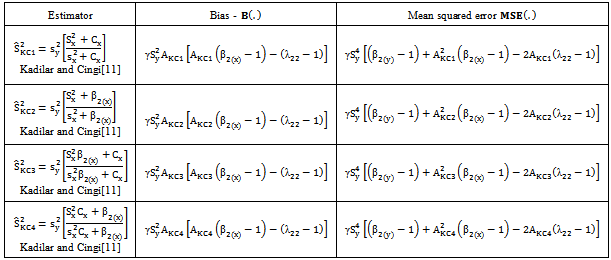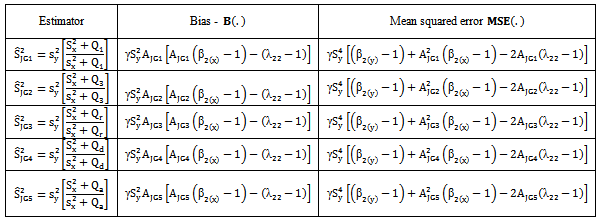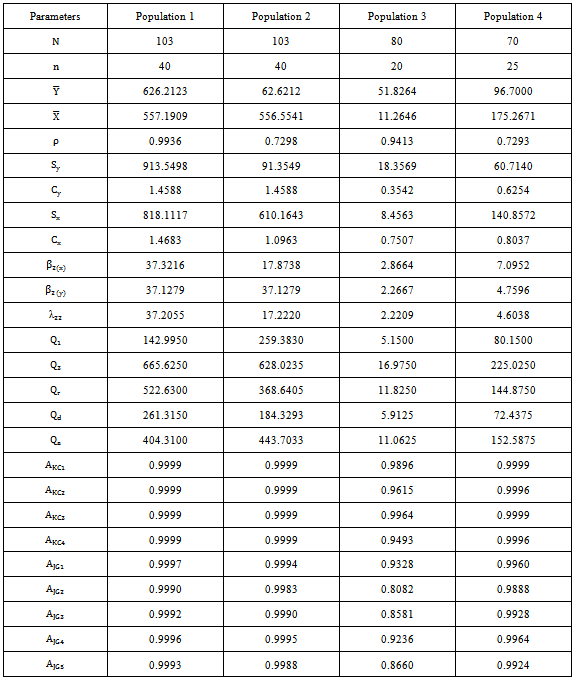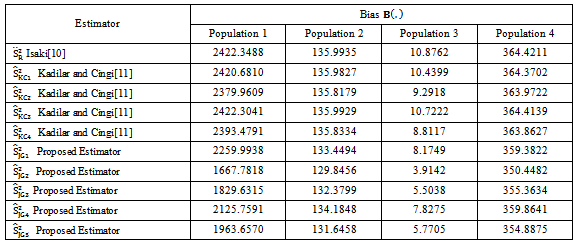-
Paper Information
- Next Paper
- Previous Paper
- Paper Submission
-
Journal Information
- About This Journal
- Editorial Board
- Current Issue
- Archive
- Author Guidelines
- Contact Us
International Journal of Statistics and Applications
p-ISSN: 2168-5193 e-ISSN: 2168-5215
2012; 2(5): 67-72
doi: 10.5923/j.statistics.20120205.04
Variance Estimation Using Quartiles and their Functions of an Auxiliary Variable
J. Subramani , G. Kumarapandiyan
Department of Statistics, Ramanujan School of Mathematical Sciences, Pondicherry University, R V Nagar, Kalapet, Puducherry, 605014, India
Correspondence to: J. Subramani , Department of Statistics, Ramanujan School of Mathematical Sciences, Pondicherry University, R V Nagar, Kalapet, Puducherry, 605014, India.
| Email: |  |
Copyright © 2012 Scientific & Academic Publishing. All Rights Reserved.
In this paper we have proposed a class of modified ratio type variance estimators for estimation of population variance of the study variable using Quartiles and their functions of the auxiliary variable are known. The biases and mean squared errors of the proposed estimators are obtained and also derived the conditions for which the proposed estimators perform better than the traditional ratio type variance estimator and existing modified ratio type variance estimators. Further we have compared the proposed estimators with that of traditional ratio type variance estimator and existing modified ratio type variance estimators for certain known populations. From the numerical study it is observed that the proposed estimators perform better than the traditional ratio type variance estimator and existing modified ratio type variance estimators.
Keywords: Inter-Quartile Range, Natural Populations, Simple Random Sampling, Semi-Quartile Average, Semi-Quartile Range
Cite this paper: J. Subramani , G. Kumarapandiyan , "Variance Estimation Using Quartiles and their Functions of an Auxiliary Variable", International Journal of Statistics and Applications, Vol. 2 No. 5, 2012, pp. 67-72. doi: 10.5923/j.statistics.20120205.04.
Article Outline
1. Introduction
- Consider a finite population
 of
of  distinct and identifiable units. Let
distinct and identifiable units. Let  be a real variable with value
be a real variable with value  measured on
measured on giving a vector
giving a vector . The problem is to estimate the populations mean
. The problem is to estimate the populations mean  or population variance
or population variance  on the basis of a random sample selected from the population
on the basis of a random sample selected from the population  . Estimating the finite population variance has great significance in various fields such as Industry, Agriculture, Medical and Biological Sciences. For example in matters of health, variations in body temperature, pulse beat and blood pressure are the basic guides to diagnosis where prescribed treatment is designed to control their variation. In this paper we intend to suggest some estimators for population variance. When there is no additional information on the auxiliary variable available, the simplest estimator of population variance is the simple random sample variance without replacement. It is common practice to use the auxiliary variable for improving the precision of the estimate of a parameter. In this paper, we consider the auxiliary information to improve the efficiency of the estimation of population variance
. Estimating the finite population variance has great significance in various fields such as Industry, Agriculture, Medical and Biological Sciences. For example in matters of health, variations in body temperature, pulse beat and blood pressure are the basic guides to diagnosis where prescribed treatment is designed to control their variation. In this paper we intend to suggest some estimators for population variance. When there is no additional information on the auxiliary variable available, the simplest estimator of population variance is the simple random sample variance without replacement. It is common practice to use the auxiliary variable for improving the precision of the estimate of a parameter. In this paper, we consider the auxiliary information to improve the efficiency of the estimation of population variance  in simple random sampling. When the information on an auxiliary variable
in simple random sampling. When the information on an auxiliary variable  is known, a number of estimators such as ratio, product and linear regression estimators are proposed in the literature.When the correlation between the study variable and the auxiliary variable is positive, ratio method of estimation is quite effective. On the other hand, when the correlation is negative, Product method of estimation can be employed effectively. Among the estimators mentioned above, the ratio estimator and its modifications are widely used for the estimation of the variance of the study variable.Estimation of population variance is considered by Isaki[10] where ratio and regression estimators are proposed. Prasad and Singh[14] have considered a ratio type estimator for estimation of population variance by improving Isaki[10] estimator with respect to bias and precision. Arcos et al.[4] have introduced another ratio type estimator, which has also improved the Isaki[10] estimator, which is almost unbiased and more precise than the other estimators.Before discussing further about the traditional ratio type variance estimator, existing modified ratio type variance estimators and the proposed modified ratio type variance estimators, the notations to be used in this paper are described below:●
is known, a number of estimators such as ratio, product and linear regression estimators are proposed in the literature.When the correlation between the study variable and the auxiliary variable is positive, ratio method of estimation is quite effective. On the other hand, when the correlation is negative, Product method of estimation can be employed effectively. Among the estimators mentioned above, the ratio estimator and its modifications are widely used for the estimation of the variance of the study variable.Estimation of population variance is considered by Isaki[10] where ratio and regression estimators are proposed. Prasad and Singh[14] have considered a ratio type estimator for estimation of population variance by improving Isaki[10] estimator with respect to bias and precision. Arcos et al.[4] have introduced another ratio type estimator, which has also improved the Isaki[10] estimator, which is almost unbiased and more precise than the other estimators.Before discussing further about the traditional ratio type variance estimator, existing modified ratio type variance estimators and the proposed modified ratio type variance estimators, the notations to be used in this paper are described below:● Population size●
Population size● Sample size●
Sample size● ●
● Study variable●
Study variable● Auxiliary variable●
Auxiliary variable● Population means●
Population means● Sample means●
Sample means● Population variances●
Population variances● Sample variances●
Sample variances● Coefficient of variations●
Coefficient of variations● Coefficient of correlation●
Coefficient of correlation● First (lower) quartile●
First (lower) quartile● Third (upper) quartile●
Third (upper) quartile● Inter-quartile range●
Inter-quartile range● Semi-quartile range●
Semi-quartile range● Semi-quartile average●
Semi-quartile average● Bias of the estimator●
Bias of the estimator● Mean squared error of the estimator●
Mean squared error of the estimator● ratio type variance estimator of
ratio type variance estimator of  ●
● Existing modified ratio type variance estimator of
Existing modified ratio type variance estimator of  ●
● Proposed modified ratio type variance estimator of
Proposed modified ratio type variance estimator of  Isaki[10] suggested a ratio type variance estimator for the population variance
Isaki[10] suggested a ratio type variance estimator for the population variance when the population variance
when the population variance  of the auxiliary variable
of the auxiliary variable  is known together with its bias and mean squared error and are as given below:
is known together with its bias and mean squared error and are as given below: | (1) |
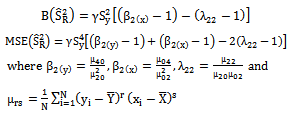 The Ratio type variance estimator given in (1) is used to improve the precision of the estimate of the population variance compared to simple random sampling when there exists a positive correlation between
The Ratio type variance estimator given in (1) is used to improve the precision of the estimate of the population variance compared to simple random sampling when there exists a positive correlation between  and
and  . Further improvements are also achieved on the classical ratio estimator by introducing a number of modified ratio estimators with the use of known parameters like Co-efficient of Variation, Co-efficient of Kurtosis. The problem of constructing efficient estimators for the population variance has been widely discussed by various authors such as Agarwal and Sithapit[1], Ahmed et al.[2], Al-Jararha and Al-Haj Ebrahem[3], Arcos et al.[4], Bhushan[5], Cochran[6], Das and Tripathi[7], Garcia and Cebrain[8], Gupta and Shabbir[9], Isaki[10], Kadilar and Cingi[11,12], Murthy[13], Prasad and Singh[14], Reddy[15], Singh and Chaudhary[16], Singh et al.[17,19], Upadhyaya and Singh[23] and Wolter[24].Motivated by Singh et al.[18], Sisodia and Dwivedi[20], and Upadhyaya and Singh[22], Kadilar and Cingi[11] suggested four ratio type variance estimators using known values of Co-efficient of variation
. Further improvements are also achieved on the classical ratio estimator by introducing a number of modified ratio estimators with the use of known parameters like Co-efficient of Variation, Co-efficient of Kurtosis. The problem of constructing efficient estimators for the population variance has been widely discussed by various authors such as Agarwal and Sithapit[1], Ahmed et al.[2], Al-Jararha and Al-Haj Ebrahem[3], Arcos et al.[4], Bhushan[5], Cochran[6], Das and Tripathi[7], Garcia and Cebrain[8], Gupta and Shabbir[9], Isaki[10], Kadilar and Cingi[11,12], Murthy[13], Prasad and Singh[14], Reddy[15], Singh and Chaudhary[16], Singh et al.[17,19], Upadhyaya and Singh[23] and Wolter[24].Motivated by Singh et al.[18], Sisodia and Dwivedi[20], and Upadhyaya and Singh[22], Kadilar and Cingi[11] suggested four ratio type variance estimators using known values of Co-efficient of variation  and Co-efficient of Kurtosis
and Co-efficient of Kurtosis  of an auxiliary variable
of an auxiliary variable  together with their biases and mean squared errors as given in the Table 1. The existing modified ratio type variance estimators discussed above are biased but have minimum mean squared errors compared to the traditional ratio type variance estimator suggested by Isaki[10]. The list of estimators given in Table 1 uses the known values of the parameters like
together with their biases and mean squared errors as given in the Table 1. The existing modified ratio type variance estimators discussed above are biased but have minimum mean squared errors compared to the traditional ratio type variance estimator suggested by Isaki[10]. The list of estimators given in Table 1 uses the known values of the parameters like  and their linear combinations. Subramani and Kumarapandiyan[21] used Quartiles and their functions of the auxiliary variable like Inter-quartile range, Semi-quartile range and Semi-quartile average to improve the ratio estimators in estimation of population mean. Further we know that the value of quartiles and their functions are unaffected by the extreme values or the presence of outliers in the population values unlike the other parameters like the variance, coefficient of variation and coefficient of kurtosis. The points discussed above have motivated us to introduce a modified ratio type variance estimators using the known values of the quartiles and their functions of the auxiliary variable. Now briefly we will discuss about quartiles and its functions. The median divides the data into two equal sets. The first (lower) quartile is the middle value of the first set, where
and their linear combinations. Subramani and Kumarapandiyan[21] used Quartiles and their functions of the auxiliary variable like Inter-quartile range, Semi-quartile range and Semi-quartile average to improve the ratio estimators in estimation of population mean. Further we know that the value of quartiles and their functions are unaffected by the extreme values or the presence of outliers in the population values unlike the other parameters like the variance, coefficient of variation and coefficient of kurtosis. The points discussed above have motivated us to introduce a modified ratio type variance estimators using the known values of the quartiles and their functions of the auxiliary variable. Now briefly we will discuss about quartiles and its functions. The median divides the data into two equal sets. The first (lower) quartile is the middle value of the first set, where  of the values are smaller than
of the values are smaller than  and
and  are larger. The third (upper) quartile is the middle value of the second set, where
are larger. The third (upper) quartile is the middle value of the second set, where  of the values are smaller than the third quartile
of the values are smaller than the third quartile  and
and  are larger. It should be noted that the median will be denoted by the notation
are larger. It should be noted that the median will be denoted by the notation  , the second quartile. The inter-quartile range is another range used as a measure of the spread. The difference between upper and lower quartiles, which is called as the inter-quartile range, also indicates the dispersion of a data set. The formula for inter-quartile range is:
, the second quartile. The inter-quartile range is another range used as a measure of the spread. The difference between upper and lower quartiles, which is called as the inter-quartile range, also indicates the dispersion of a data set. The formula for inter-quartile range is: | (2) |
 and
and  . The formula for semi-quartile range is:
. The formula for semi-quartile range is: | (3) |
 and defined as:
and defined as: | (4) |
|

2. Proposed Estimators Using Quartiles and Their Functions
- In this section we have suggested a class of modified ratio type variance estimators using the quartiles and their functions of the auxiliary variable like Inter-quartile range, Semi-quartile range and Semi-quartile averageThe proposed class of modified ratio type variance estimators
 for estimating the population variance
for estimating the population variance  together with the first degree of approximation, the biases and mean squared errors and the constants are given below:
together with the first degree of approximation, the biases and mean squared errors and the constants are given below:
|

3. Efficiency of the Proposed Estimators
- As we mentioned earlier the bias and mean squared error of the traditional ratio type variance estimator are given below:
 | (5) |
 | (6) |
 | (7) |
 | (8) |
 In the same way, the biases and mean squared errors of the proposed modified ratio type variance estimators given in Table 2 are represented in a single class as given below:
In the same way, the biases and mean squared errors of the proposed modified ratio type variance estimators given in Table 2 are represented in a single class as given below:  | (9) |
 | (10) |
 From the expressions given in (6) and (10) we have derived the condition for which the proposed estimators
From the expressions given in (6) and (10) we have derived the condition for which the proposed estimators
 are more efficient than the traditional ratio type variance estimator and it is given below:
are more efficient than the traditional ratio type variance estimator and it is given below: | (11) |

 are more efficient than the existing modified ratio type variance estimators given in Table 1,
are more efficient than the existing modified ratio type variance estimators given in Table 1, 
 and are given below:
and are given below: | (12) |
4. Numerical Study
- The performance of the proposed modified ratio type variance estimators are assessed with that of traditional ratio type estimator and existing modified ratio type variance estimators listed in Table 1 for certain natural populations. The populations 1 and 2 are the real data set taken from the Report on Waste 2004 drew up by the Italian bureau for the environment protection-APAT. Data and reports are available in the website http://www.osservatorionazionalerifiuti.it[25]. In the data set, for each of the Italian provinces, three variables are considered: the total amount (tons) of recyclable-waste collection in Italy in 2003
 , the total amount of recyclable-waste collection in Italy in 2002
, the total amount of recyclable-waste collection in Italy in 2002  and the number of inhabitants in 2003
and the number of inhabitants in 2003  . The population 3 is taken from Murthy[13] given in page 228 and population 4 is taken from Singh and Chaudhary[16] given in page 108. The population parameters and the constants computed from the above populations are given below:
. The population 3 is taken from Murthy[13] given in page 228 and population 4 is taken from Singh and Chaudhary[16] given in page 108. The population parameters and the constants computed from the above populations are given below:
|
|
|
5. Conclusions
- Estimating the finite population variance has great significance in various fields such as Industry, Agriculture, Medical and Biological sciences, etc. In this paper we have proposed a class of modified ratio type variance estimators using the quartiles and their functions of the auxiliary variable like Inter-quartile range, Semi-quartile range and Semi-quartile average. The biases and mean squared errors of the proposed modified ratio type variance estimators are obtained and compared with that of traditional ratio type variance estimator and existing modified ratio type variance estimators. Further we have derived the conditions for which the proposed estimators are more efficient than the traditional and existing estimators. We have also assessed the performance of the proposed estimators for some known natural populations. It is observed that the biases and mean squared errors of the proposed estimators are less than the biases and mean squared errors of the traditional and existing modified estimators for certain known populations. Hence we strongly recommend that the proposed modified ratio type variance estimator may be preferred over the traditional ratio type variance estimator and existing modified ratio type variance estimators for the use of practical applications.
ACKNOWLEDGEMENTS
- The second author wishes to acknowledge his sincere thanks to the Vice Chancellor, Pondicherry University for the financial support to carry out this research work through the University Fellowship.
 Abstract
Abstract Reference
Reference Full-Text PDF
Full-Text PDF Full-Text HTML
Full-Text HTML